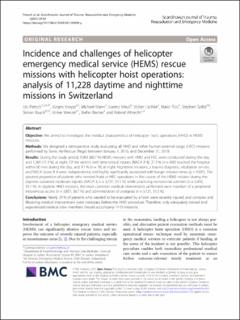| dc.contributor.author | Pietsch, Urs | |
| dc.contributor.author | Knapp, Jürgen | |
| dc.contributor.author | Mann, Michael E. | |
| dc.contributor.author | Meuli, Lorenz | |
| dc.contributor.author | Lischke, Volker | |
| dc.contributor.author | Tissi, Mario | |
| dc.contributor.author | Sollid, Stephen J. M. | |
| dc.contributor.author | Rauch, Simon | |
| dc.contributor.author | Wenzel, Volker | |
| dc.contributor.author | Becker, Stefan | |
| dc.contributor.author | Albrecht, Roland | |
| dc.coverage.spatial | Switzerland | en_US |
| dc.date.accessioned | 2021-10-19T10:46:33Z | |
| dc.date.available | 2021-10-19T10:46:33Z | |
| dc.date.created | 2021-09-20T11:13:11Z | |
| dc.date.issued | 2021-07 | |
| dc.identifier.citation | Pietch, U., Knapp, J., Mann, M. et al. (2021) Incidence and challenges of helicopter emergency medical service (HEMS) rescue missions with helicopter hoist operations: analysis of 11,228 daytime and nighttime missions in Switzerland, 29, 92. | en_US |
| dc.identifier.issn | 1757-7241 | |
| dc.identifier.uri | https://hdl.handle.net/11250/2823854 | |
| dc.description.abstract | Objective
We aimed to investigate the medical characteristics of helicopter hoist operations (HHO) in HEMS missions.
Methods
We designed a retrospective study evaluating all HHO and other human external cargo (HEC) missions performed by Swiss Air-Rescue (Rega) between January 1, 2010, and December 31, 2019.
Results
During the study period, 9,963 (88.7 %) HEMS missions with HHO and HEC were conducted during the day, and 1,265 (11.3 %) at night. Of the victims with time-critical injuries (NACA ≥ 4), 21.1 % (n = 400) reached the hospital within 60 min during the day, and 9.1 % (n = 18) at night. Nighttime missions, a trauma diagnosis, intubation on-site, and NACA Score ≥ 4 were independently and highly significantly associated with longer mission times (p < 0.001). The greatest proportion of patients who needed hoist or HEC operations in the course of the HEMS mission during the daytime sustained moderate injuries (NACA 3, n = 3,731, 37.5 %) while practicing recreational activities (n = 5,492, 55.1 %). In daytime HHO missions, the most common medical interventions performed were insertion of a peripheral intravenous access (n = 3,857, 38.7 %) and administration of analgesia (n = 3,121, 31.3 %).
Conclusions
Nearly 20 % of patients who needed to be evacuated by a hoist were severely injured, and complex and lifesaving medical interventions were necessary before the HHO procedure. Therefore, only adequately trained and experienced medical crew members should accompany HHO missions. | en_US |
| dc.language.iso | eng | en_US |
| dc.publisher | BioMed Central | en_US |
| dc.rights | Navngivelse 4.0 Internasjonal | * |
| dc.rights.uri | http://creativecommons.org/licenses/by/4.0/deed.no | * |
| dc.subject | traumatologi | en_US |
| dc.subject | luftambulanse | en_US |
| dc.subject | redningsarbeid | en_US |
| dc.subject | HEMS | en_US |
| dc.subject | Sveits | en_US |
| dc.title | Incidence and challenges of helicopter emergency medical service (HEMS) rescue missions with helicopter hoist operations: analysis of 11,228 daytime and nighttime missions in Switzerland | en_US |
| dc.type | Peer reviewed | en_US |
| dc.type | Journal article | en_US |
| dc.description.version | publishedVersion | en_US |
| dc.rights.holder | © The Author(s) 2021 | en_US |
| dc.subject.nsi | VDP::Medisinske Fag: 700 | en_US |
| dc.source.volume | 29 | en_US |
| dc.source.journal | Scandinavian Journal of Trauma, Resuscitation and Emergency Medicine | en_US |
| dc.identifier.doi | 10.1186/s13049-021-00898-y | |
| dc.identifier.cristin | 1935879 | |
| dc.relation.project | Norges forskningsråd: 275367 | en_US |
| dc.relation.project | SHARE - Centre for Resilience in Healthcare: 5091 | en_US |
| dc.source.articlenumber | 92 (2021) | en_US |
| cristin.ispublished | true | |
| cristin.fulltext | original | |
| cristin.qualitycode | 1 | |

